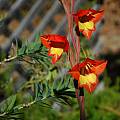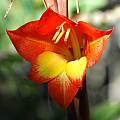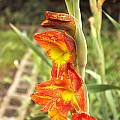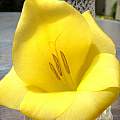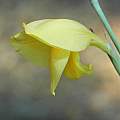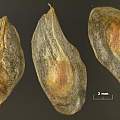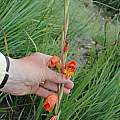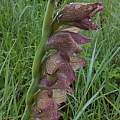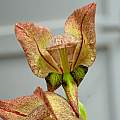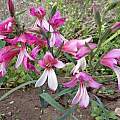Gladiolus species on this page are not (or not exclusively) from Southern Africa. Most are Eurasian with additional African species from Kenya, Ethiopia, and Tanzania.
Gladiolus index - Southern African Gladiolus A-B - Southern African Gladiolus Ca - Southern African Gladiolus Ce-E - Southern African Gladiolus F-H - Southern African Gladiolus I-Me -- Southern African Gladiolus Mi-Pa - Southern African Gladiolus Pe-R - Southern African Gladiolus S-T - Southern African Gladiolus U-Z - Gladiolus Hybrids
African Gladiolus
Though the main focus of diversity in Gladiolus lies in South Africa and few surrounding countries, some species hail from more northern parts of the continent.
Gladiolus dalenii Van Geel is a widespread and common species found not only in Southern Africa, but also in other parts of tropical Africa. It has been known by a number of names over the years; there have been 27 synonyms for the tropical Africa and Madagascar forms and 14 more for the southern African forms. The main synonyms for the southern Africa collections have been Gladiolus natalensis and Gladiolus psittacinus. This species blooms at different times of the year depending on the location, but there are probably flowers every month of the year somewhere in its native habitats. Flowers are either red to orange with yellow markings on the lower half of the three lower tepals or yellow to greenish with red to brown streaks on the upper tepals. Plants can grow 1-2 m high. Although it favors moist habitats and is often found in grassland, it can also be found in dry habitats with only a short wet season. The ones I grew in Northern California lived for a number of years in the garden, dormant during our wet winters, appearing late spring and surviving through the dry summer and blooming in the fall. The flowering stalks were very tall with a number of flowers. Photos 1-2 of those plants were taken by Mary Sue Ittner. Photo 3 by Cameron McMaster shows plants in cultivation. Photos 4-5 by Mary Hunter and Mary Sue Ittner show the first bloom from seed of a yellow form of ssp. dalenii, once known as Gladiolus primulinus blooming in late summer in Northern California. The last photo by David Pilling shows seed.
The first photo below from Cameron McMaster shows flowering plants in habitat in the Eastern Cape. The second is another habitat shot taken near Balloch in the Eastern Cape, January 2010 by Bob Rutemoeller. Photo Nr. 3 from Rachel Saunders shows an unusual color form and was taken in northern KwaZulu-Natal in January 2015. The last photo shows the beautiful detail on likely the same color form, as the seeds were obtained from Silverhill, flowering the second year from seed for Martin Bohnet.
Gladiolus magnificus (Harms) Goldblatt is a southern tropical African species found from central Angola through southern Zambia to western Zimbabwe. It is also found in the northern edges of Namibia and Botswana. In the past this species has been included in Antholyza under three species names as well as being included in Chasmanthe and Oenostachys. It has bright red flowers with a long perianth tube and reduced lower tepals with yellow markings. Tepals are very unequal with the dorsal the largest, hooded and horizontal. The laterals are broadly lanceolate and directed forward. Height range: 80-140 cm. It flowers in January and February. Photo from iNaturalist taken by Cody Coyotee Howard in Namibia and shared under a CC BY-NC license.
Gladiolus murielae syn. Acidanthera bicolor , Gladiolus callianthus , and Acidanthera murielae is a species with a wide distribution from northeastern Africa southward to Mozambique. It is often sold or described under the Acidanthera synonyms or, as it is most common in northern Ethiopia, sometimes called Abyssinian gladiolus. This species has long tubed white flowers with dark purple markings in the midline on the lower tepals or all tepals and is fragrant, more strongly at night. Height range: 70-100 cm. Since it comes from a tropical climate, it is often protected in colder climates and dug in the winter and stored and replanted after the last frost so that it will be summer growing, blooming late summer into fall. Photo 1 by Arnold Trachtenberg of plants blooming in the Brooklyn Botanical Garden, Photo 2 by Martin Bohnet illustrates the length of the tube.
Gladiolus watsonioides Baker is found on the mountains of Kenya and northern Tanzania, growing from 2600 m to 3900 m. It is not quite a true alpine, but not far off. There is a frost almost every night and the plant copes with this well at all stages of its growth. With the almost constant daylength and general conditions through the year the plant can remain active without going dormant. This evergreen habit is maintained in cultivation & the plants remain green throughout the year if kept moist, but they can go dormant if they dry out. I have stocks from both mountains (Kilimanjaro and Mt. Kenya) and they grow equally well in a gritty, humus-rich compost in deep pots in a frost-free greenhouse, but there is no doubt that the Mt Kenya version is the one to grow. Height range: 1 to 2.3 ft. Description and photos by John Grimshaw. The last two images are of the Mt. Kenya version.
Eurasian Gladiolus
When first describing Gladiolus, Carl von Linné choose an European point of view, setting Gladiolus communis as the type species for the genus. Considering the high variability of the South African species, the Eurasians seem rather uniform with their bloom colors mostly centering around magenta. Another shared feature of the Eurasian species is their high chromosome count ranging from 60 (tetraploid, considering 15 as base count for Gladiolus in general) to 180 in some populations of Gladiolus italicus.
Gladiolus sp. The photo below shows a plant grown from seed obtained from Monocot Nursery under the name Gladiolus dubius, which I cannot verify. The Kew monocot list states that name is an invalid name for Gladiolus italicus. It has relatively large flowers for a Eurasian species. Photo by Jane McGary. For more information about this species see Angelo Porcelli's article entitled Gladiolus of Southern Italy.
Gladiolus anatolicus is a small species, only 15-30 cm with 3-4 flowers. Growing in Macchie at low elevations in S, SW Turkey and the adjacent Islands, blooming in March-April. Photo was taken in SW turkey by Oron Peri
Gladiolus atroviolaceus is native to Greece, Turkey, Iraq and Iran and has deep violet-purple flowers and blooms spring to summer. Height: to 60 cm. First photo by Jane McGary of a plant grown from seed purchased from Jim and Jenny Archibald as Gladiolus antakiensis but not that species. Second photo was taken in its habitat South of Madaba in Jordan by Oron Peri.
Gladiolus byzantinus is considered to be a synonym of Gladiolus communis by The Plant List and the Kew checklist. Angelo Porcelli makes a case for it to be considered a species in its own right in his paper Gladiolus of Southern Italy. In this paper he describes the differences between it and Gladiolus communis and Gladiolus italicus. This paper also shows the difference between the seeds and the corms. This species grows up to 40 inches (100 cm). The central tepal of the three lower tepals is visibly longer and even wider than Gladiolus communis. The upper central tepal points up and the mid tepals are rhomboid shaped. It is usually a dark rich purple. Gladiolus byzantinus has large winged seeds of about 1 cm. The corm tunics dissolve (separate) at the apex with parallel and much wider veins. Photos by Angelo Porcelli.
Gladiolus communis is listed on The Plant List with 23 synonyms. It is distributed from the Mediterranean to Caucasus. The species names byzantinus and communis are often given as synonyms and you often see Gladiolus byzantinus ssp. communis, Gladiolus communis ssp. byzantinus, and Gladiolus communis var. byzantinus. It is deep purple-red with narrow, paler marks outlined in dark purple on the lower lobes. In Angelo Porcelli's paper Gladiolus of Southern Italy he explains the difference between this species, Gladiolus byzantinus and Gladiolus italicus. This species grows up to 40 inches (100 cm). The three lower tepals are more or less the same length and width. The upper central tepal is hooded. G. communis often has a slight two-tone effect on the lower tepals, but this is not a reliable feature, as many individuals are a solid color. The median tepals have a "spoon" shape. The seeds are winged, 3 to 5 mm and corm tunics have very close parallel veins. The plants in the first photo below from Bob Rutemoeller were blooming at Kew Gardens in May 2004 under the label Gladiolus communis subsp. byzantinus. The next two photos were taken from the article by Angelo Porcelli mentioned above.
Gladiolus illyricus is native to south and west Europe and the Mediterranean region, growing on heaths, in scrub and open woods. It flowers April to August and is similar to G. communis with flowers facing in two directions but is usually shorter with 3 to 10 flowers on a rarely branched stem. Flowers are magenta purple with white markings on the lower 3 lobes. Photos taken by Mary Sue Ittner of plants grown from seed labeled this and hopefully are correctly identified.
Gladiolus imbricatus L., known as the Turkish Marsh Gladiolus, is native to southeastern Europe and Turkey. It grows in wet meadows and marshes and flowers from May to July. Growing 30 to 80 cm, it has a dense spike of 4 to 12 pale carmine to deep purple flowers. The lower lobes have white lanceolate marks outlined in purple. Its lowest leaf is round or blunt, not sharp which is another distinguishing characteristic. Photos from iNaturalist were taken by Jonas Barzdenas in June in Lithuania and Cristina Florentina Alistar in Romania in July and shared under a CC BY-NC license. The last two photos were taken by Ramunė Vakarė in Lithuania in July and shared under a CC BY-SA license.
Gladiolus italicus has a broad distribution from southern Europe to parts of Asia growing on rocky hillsides, grassy areas, open forests and in fields. It flowers from March to July. Theophrastus wrote that the corm when pounded and mixed with flour made bread sweeter. It is distinguished from other European Gladiolus by having anthers that are longer than the filaments. Flowers are loosely arranged and facing various directions, pale pink as well as purple-pink to magenta with a pale blotch outlined in purple on the lower lobes. There are 5 to 15 flowers on the spike. Photos 1-2 taken by Mary Sue Ittner show the flowers of a plant grown from seed labeled G. italicus. Photo 3 was taken by Nhu Nguyen. Photos 4-6 by M. Gastil-Buhl include a close-up showing the relative length of anthers and stigma, a flower spike and corms still in the clusters as found when excavated against a 1 cm grid. The corms were found growing between 3 to 5 inches deep, including layers of added compost and grit. All of these corms and more grew in 2 years from just 4 juvenile corms.
Photos from Angelo Porcelli. The first is a close-up taken in habitat. The last three photos were taken from his article Gladiolus of Southern Italy. In this article he explains the difference between this species and Gladiolus byzantinus and Gladiolus communis. Gladiolus italicus is smaller, averaging 20 to 23 inches (50-60 cm) and has flowers with an "open" shape; the lateral tepals are oblong, narrow and well spaced, not overlapping the upper tepal and the two lower ones. Seed is quite different in this species from the other two which have winged seed. Seed looks like small pepper grains with three to four angles. Corms have a peculiar net on the tunics, especially on the top of the corm, and are a rather light brown color. This species is highly bulbilliferous and increases by cormlets at an alarming rate and a single corm will turn in a clump in a few years.
Gladiolus palustris Gaudin is native to central and northwestern Europe, the most northerly range in the genus, and is suitable for ordinary to moist border conditions, as well as a bog garden. The normal flower color is rosy violet. Photos 1-4 from Hans Joschko. The pictured white form in photo 5 from Jane McGary was grown from seed sent by Ole Olsen of Norway, who cultivates the parent plants as a "blue" form. This species faces only one direction and does not have more than 6 flowers on a spike. We have been told this may be misnamed, but have not been given another name.
Gladiolus triphyllus Ker Gawl. , the smallest species of Eurasian Gladiolus, is endemic of the island of Cyprus, especially common on Akamas peninsula, but reported to be recently found in nearby Lebanon coasts too. It is winter growing, with 2-3 narrow leaves and a spike of up to 6 flowers in cultivation, but less in habitat.
Photo by Angelo Porcelli
Gladiolus index - Southern African Gladiolus A-B - Southern African Gladiolus Ca - Southern African Gladiolus Ce-E - Southern African Gladiolus F-H - Southern African Gladiolus I-Me -- Southern African Gladiolus Mi-Pa - Southern African Gladiolus Pe-R - Southern African Gladiolus S-T - Southern African Gladiolus U-Z - Gladiolus Hybrids
